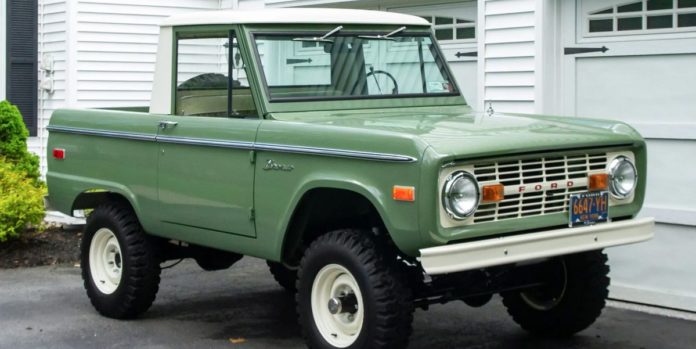- Ford’s off-road stallion debuted in 1966 with wagon, roadster, and Half-Cab pickup body styles. The latter two proved unpopular and were discontinued after a few years.
- Half-Cab pickups comprised less than 10 percent of first-generation Bronco production and are now highly prized by fans.
- Many early Broncos have been modified with big fender flares, V-8s, and other modern touches, but this one’s been restored to its original farm-truck spec, with a 170-cubic-inch inline-six and a three-speed manual.
Ironically, the first time anybody referred to a Ford Bronco as a “Sports Utility,” they were actually talking about this little truck. It may be Dearborn’s most storied SUV now, but the original Bronco offered three distinct body styles: Roadster, Pickup, and Wagon. In 1966, SUVs were still a new idea, and there wasn’t a universal language to describe them, so Ford’s marketers called the truck version “Sports Utility.” In 1967, they relabeled it the Bronco Pickup, but it was years before people commonly referred to Broncos as SUVs.
Today, Bronco fans refer to the pickup as the “Half-Cab,” but like the Roadster, it’s largely forgotten by the public. Both proved poor sellers and were eventually discontinued, leaving only the Wagon. This 1971 Ford Bronco Pickup for sale on Bring a Trailer (which, like Car and Driver, is part of Hearst Autos) offers a rare glimpse into the Bronco’s history for two reasons. It’s one of just 1502 built that year, but even more unusually, it’s a restored base model.
Ford executive Don Frey, who also helped create the Mustang, got the idea for a “Four-wheel-drive sports car” after seeing the success of the 1961 International Harvester Scout. In the 1950s, off-roading had been the domain of bare-bones Jeeps and home-built four-wheel-drive conversions. The Scout, in contrast, provided a relatively civilized alternative with car-like comforts to an appreciative audience. Frey conducted hundreds of interviews with Jeep and Scout owners to see how Ford could improve the idea, and the Bronco was the result.
After Frey and Lee Iacocca presented their findings, they were given a $10M budget ($35M less than the Mustang’s) and 18 months to develop the SUV. Frey’s extensive research helped the engineers, led by Paul Axelrad, set the vehicle’s basic parameters. It’d ride on a 92-inch wheelbase and be 152 inches long, with minimal overhangs and a break-over angle superior to that of the Scout or the Jeep CJ-5.
Since Axelrad’s budget was so small, the Bronco used many off-the-shelf components, including the Falcon’s 100-hp, 170-cubic-inch Thriftpower six. Ford’s 289- and later 302-cubic-inch V-8s were optional. Until 1973, all Broncos came only with a three-on-the-tree manual.
The Bronco was built to be light, rigid, and have a tight turning circle. Its masterfully minimalist styling, meant to suggest utility and simplicity, grew from studies penned by Ford’s first African American designer, McKinley Thompson Jr. The shape hid a mixture of sophisticated off-road gear and on-road comfort. Four-wheel drive was standard, and it was the first vehicle to use the open-knuckle Dana 30 front axle. The brakes weren’t great, but the coil-sprung “mono-beam” front suspension and long-travel springs made it a smooth driver by 1960s standards.
Frey’s research helped shape a good design but couldn’t entirely predict how customers would buy Broncos. Like International, Ford figured many would want pickups, and early brochures mentioned uses like construction site work and ranching. In practice, the Bronco Pickup was just too small and specialized to appeal to most buyers.
Where Bronco Wagons have a back seat and a full-length removable top, Half-Cabs have a sloping, bolted-in metal bulkhead behind the front bench seat, a smaller removable top, and a tiny bed measuring 46.8 inches long at the upper edge. While 6930 were sold in 1966, the Half-Cab quickly lost steam. From 1967 to 1972, Ford usually sold ten or more Wagons for every Pickup. Ford axed the Half-Cab entirely when it began importing the Mazda-based Courier pickup that year. Fewer than 20,000 were made in total.
Early Broncos have since developed a huge following, and there’s a cottage industry of big-buck custom builds and resto-modded versions. Most restored versions pack V-8s, more highway-friendly transmissions, big fender flares, and other modern touches. This one goes in the opposite direction. From 2015 to 2019, it was treated to a frame-off restoration to its original spec. The only modifications are a slight suspension lift, a cabin heater, and an aftermarket stereo.
Inside, there’s a vinyl bench seat and a painted metal dash. It’s almost as basic as a Bronco could be in 1971, though the original owner splurged on $300 worth of options, including a radio and body side moldings. Yes, it’s slow, but this is as close to a factory-fresh, basic Bronco pickup as you can get, and it’d probably be lots of low-speed fun on the trail.
If you’re looking for the perfect antidote to resto-mod mania, the auction ends May 28.




